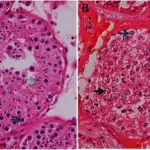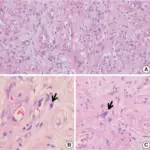Inflammation of the testis or epididymis is a medical condition characterized by pain, swelling, redness and hotness, and sometimes loss of function of the testis.
Examples of inflammation of the testis or epididymis includes:
- Inflammation of the testis or epididymis due to gonorrhea
- Inflammation of the testis or epididymis due to syphilis
- Inflammation of the testis or epididymis due to mumps
- Inflammation of the testis or epididymis due to tuberculosis
- Autoimmune orchitis aka granulomatous orchitis
- Nonspecific epididymitis
- Nonspecific orchitis
| Type of inflammation &Cause | Presentation | Diagnosis | Treatment | Prognosis |
| Gonorrhea | Development of frank abscesses in the epididymis, resulting in extensive destruction of this organ | Inflammation of the Testis or Epididymis diagnosed through medical history and examination. Laboratory studies-complete blood count, Imaging studies- scrotal ultrasonography | Inflammation of the Testis or Epididymis treated through medical care treating underlying causes, Surgical incision | Inflammation of the Testis or Epididymis prognosis is good with proper treatment of the underlying cause. |
| Syphilis | The morphologic pattern takes two forms: a diffuse interstitial inflammation branded by edema, and plasma cell and lymphocytic penetration with the typical hallmark of all syphilitic contagions | |||
| Mumps | Interstitial orchitis progresses 1 week after start of swelling to the parotid glands | |||
| Tuberculosis | Raises the classic morphological responses of caseating granulomatous inflammation that are distinctive of tuberculosis illness. | |||
| Autoimmune Orchitis aka Granulomatous Orchitis | A painless testicular mass imitating a testicular tumor. Histologically, the orchitis is illustrious by granulomas seen confined in spermatic tubules. | |||
| Nonspecific Epididymitis & Nonspecific Orchitis caused by sexually transmitted pathogens Chlamydia trachomatis and Neisseria gonorrhoeae | Infection limited to the interstitial connective tissue, extends involving the tubules and progress to free abscess formation or whole suppurative necrosis of the epididymis. The infection extends into the testis |



